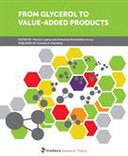Explore

From Glycerol to Value-Added Products
0 Ungluers have
Faved this Work
Login to Fave
In a context where the role of biofuels will continue to grow, it is necessary to take into account the current state of their various manufacturing processes and to anticipate the expansion of the market. Thus, current biodiesel production processes generate a significant amount of glycerol as a by-product (about 100 kg per ton of processed vegetable oil). An explosion of the biodiesel market must integrate the valorization of glycerol whose current market of distribution (cosmetics, drugs, polymers, etc.) is not guaranteed such an expansion. This valuation will contribute effectively to the profitability and sustainability of the processes from which it derives. Glycerol physicochemical and toxicological properties give it the potential to be used as solvent, biolubricant, dispersant, and surfactant, among others. It is also widely used in the food industry as a preservative and sweetener. Beyond these applications, glycerol can also be used as a raw material for a wide range of chemicals. Glycerol is a highly functionalized molecule with specific physico-chemical properties, which can be used in different reactions as a reactant or a building block. For example, glycerol can be used as a starting material for antibiotic production, biosurfactants, organic acid production (lactic, propionic, succinic, citric acid, glyoxylic acid, glyoxalic acid, amino acids, etc.), alcohols (propanediols), glycerol esters, acrolein production, etc. These products can be obtained either through chemical reactions such as acetalization, dehydration, glycerolysis, esterification, etherification, aqueous phase reforming, oxidation, carboxylation, electrochemical routes, or through enzymatic reactions. However, it must be kept in mind that the development of industrial processes relies on the use of crude glycerol from biodiesel production. For that purpose, robust processes involving impurities-insensitive catalysts or pre-purification have to be developed. Finally, the separation of the chemical products obtained after glycerol conversion is also a key step toward the development of viable glycerol-based processes.
This book is included in DOAB.
Why read this book? Have your say.
You must be logged in to comment.
Rights Information
Are you the author or publisher of this work? If so, you can claim it as yours by registering as an Unglue.it rights holder.Downloads
This work has been downloaded 154 times via unglue.it ebook links.
- 53 - mobi (CC BY) at Unglue.it.
- 53 - epub (CC BY) at Unglue.it.
- 48 - pdf (CC BY) at Unglue.it.
Keywords
- Activation
- added value bio-based products
- Catalysis
- electrochemical conversions
- glycerol
- Green chemistry
- Mathematics & science
- Process
- Science: general issues
Links
DOI: 10.3389/978-2-88963-577-1Editions

